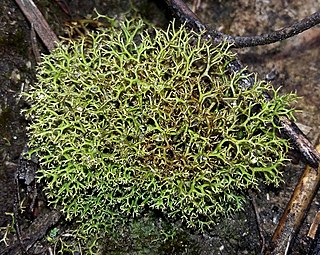
The Cladoniaceae are a family of lichenized fungi in the order Lecanorales. It is one of the largest families of lichen-forming fungi, with about 560 species distributed amongst 17 genera. The reindeer moss and cup lichens (Cladonia) belong to this family. The latter genus, which comprises about 500 species, forms a major part of the diet of large mammals in taiga and tundra ecosystems. Many Cladoniaceae lichens grow on soil, but other can use decaying wood, tree trunks, and, in a few instances, rocks as their substrate. They grow in places with high humidity, and cannot tolerate aridity.

The Peltigeraceae are a family of lichens in the order Peltigerales. The Peltigeraceae, which contains 15 genera and about 600 species, has recently (2018) been emended to include the families Lobariaceae and Nephromataceae. Many Peltigeraceae species have large and conspicuous, leathery thalli. They largely occur in cool-temperate to tropical montane climates. Tripartite thalli involving fungus, green algae and cyanobacteria are common in this family.

The Pannariaceae are a family of lichens in the order Peltigerales. Species from this family have a widespread distribution, but are especially prevalent in southern temperate regions.
Sphaerophoropsis is a genus of lichenized fungi in the family Cladoniaceae. A monotypic genus, Sphaerophoropsis contains the single species Sphaerophoropsis stereocauloides. Both the genus and species were described as new to science in 1890 by Finnish lichenologist Edvard August Vainio, from collections made in Brazil.

Pycnothelia is a genus of lichen-forming fungi in the family Cladoniaceae. Pycnothelia was promoted to generic status by French naturalist Léon Jean Marie Dufour in 1821; it was originally circumscribed by Erik Acharius in 1799 as a section of the now-defunct genus Cenomyce.

Pilophorus is a genus of lichenized fungi in the family Cladoniaceae. They are commonly known as matchstick lichens. The genus has a widespread distribution, especially in temperate regions, and contains 11 species.
Notocladonia is a genus of two Australasian species of lichenized fungi in the family Cladoniaceae. The genus was circumscribed by lichenologist Samuel Hammer in 2003. The type species, Notocladonia cochleata, was previously placed in the genus Ramalea.
Myelorrhiza is a genus of two Australian species of lichenized fungi in the family Ramalinaceae. It was circumscribed in 1986 by Australian lichenologists Doug Verdon and John A. Elix. Myelorrhiza was originally classified in the family Cladoniaceae until Kistenich and colleagues, using molecular phylogenetic analysis, showed that it is more appropriately placed with the Ramalinaceae.
Heteromyces is a genus of lichenized fungi in the family Cladoniaceae. It is a monotypic genus, containing the single species Heteromyces rubescens. Both the genus and species were described by Swiss lichenologist Johannes Müller Argoviensis in 1889. The name Heteromyces was also used for a genus circumscribed by Lindsay S. Olive in 1957; this usage is illegitimate because of the prior usage of this name by Müller. Olive's concept of Heteromyces was renamed to Oliveonia by Marinus Anton Donk in 1958.

Cladia is a genus of lichen-forming fungi in the family Cladoniaceae. Cladia species have a crustose or squamulose (scaly) primary thallus and a fruticose, secondary thallus, often referred to as pseudopodetium. The type species of the genus, Cladia aggregata, is widely distributed, occurring in South America, South Africa, Australasia and South-East Asia to southern Japan and India. Most of the other species are found in the Southern Hemisphere.
Carassea is a genus of lichenized fungi in the family Cladoniaceae. The genus was circumscribed in 2002 by Finnish lichenologist Soili Stenroos. A monotypic genus, Carassea contains the single species Carassea connexa. This species, originally named Cladonia connexa, was first documented by Edvard August Wainio, who collected specimens from Minas Gerais, Brazil, in 1885, and published a description of the species in the first of his three-volume Monographia Cladoniarum universalis. The Cladoniaceae genera most closely related to Carassea include Pycnothelia and Metus.

Stirtoniella is a lichen genus in the family Ramalinaceae. It is a monotypic genus, containing the single species Stirtoniella kelica, a crustose and corticolous lichen originally described from New Zealand in 1873 as a species of Lecidea. The photobiont is an alga of the family Chlorococcaceae. The genus is named after Scottish mycologist James Stirton.
Psoromidium is a genus of lichens in the family Pannariaceae. It has three species. The genus was circumscribed by Scottish naturalist James Stirton in 1877, with Psoromidium wellingtonii assigned as the type species.

Parmeliella is a genus of lichenized fungi in the family Pannariaceae. It occurs mainly in the tropics and sub-tropics, with species found in Africa, Asia, Australasia and South America. A recent (2020) estimate places 41 species in the genus.

Pannaria is a genus of lichen-forming fungi in the family Pannariaceae. The widespread genus contains an estimated 51 species, found primarily in tropical regions.
Fuscoderma is a genus of lichenized fungi in the family Pannariaceae. It was originally circumscribed as a subgenus of the genus Leioderma by David Galloway and Per Magnus Jørgensen in 1987. The same authors promoted it to generic status a couple of years later in 1989. The New Guinean species F. papuanum was added to the genus in 2002.

Degelia is a genus of lichen-forming fungi in the family Pannariaceae. The genus is named after Swedish lichenologist Gunnar Degelius.
Parasiphula is a genus of crustose lichens in the family Coccotremataceae. The genus was circumscribed by Gintaras Kantvilas and Martin Grube in 2006, and contains seven species that are known from cool to cold latitudes in the Southern Hemisphere.

Solenopsora is a genus of lichen-forming fungi in the family Catillariaceae. It has 15 species, with a mostly Northern Hemisphere distribution.

Crocodia is a genus of foliose lichens in the family Peltigeraceae. It has eight species. The genus has a cosmopolitan distribution, although most species occur in temperate and tropical regions of the Southern Hemisphere. The main characteristics of the genus that separate it from its parent genus, Pseudocyphellaria, include a yellow medulla and yellow pseudocyphellae on the lower thallus surface.










